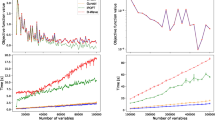Abstract
Planning energy production is a challenging task due to its cost-sensitivity, fast-moving energy markets, uncertainties in demand, and technical constraints of power plants. Thus, more complex models of this so-called unit commitment problem (UCP) have to be solved more rapidly, a task that probably can be solved more efficiently via quantum computing. In this article, we model a UCP with minimum running and idle times as a quadratic unconstrained optimization problem to solve it on quantum computing hardware. First experiments confirm the advantages of our formulation in terms of qubit usage and connectivity and most importantly solution quality.
Access this chapter
Tax calculation will be finalised at checkout
Purchases are for personal use only
Similar content being viewed by others
Notes
- 1.
Remark that in our example this parameter is set to 1 and does not need any binarization, increased parameter values worsen the generic model.
References
Ajagekar, A., & You, F. (2019). Quantum computing for energy systems optimization: Challenges and opportunities. Energy, 179. https://doi.org/10.1109/TPWRS.2022.3141794
Bermejo, P., & Orus, R. Variational quantum continuous optimization: A cornerstone of quantum mathematical analysis. https://doi.org/10.48550/arXiv.2210.03136
Cao, Y., Romero, J., Olson, J., Degroote, M., Johnson, P., Kieferová, M., Kivlichan, I., Menke, T., Peropadre, B., Sawaya, N., Sim, S., Veis, L., & Aspuru-Guzik, A. (2019). Quantum chemistry in the age of quantum computing. Chemical Reviews, 119(19), 10856–10915. https://doi.org/10.1021/acs.chemrev.8b00803
Egger, D., Mareček, J., & Woerner, S. (2021). Warm-starting quantum optimization. Quantum 5, 479. https://doi.org/10.1287/ijoc.2019.0944
Glover, F., Kochenberger, G., Hennig, R. et al. (2022). Quantum bridge analytics I: A tutorial on formulating and using QUBO models. Annals of Operations Research, 314, 141–183. https://doi.org/10.1007/s10479-022-04634-2
Knueven, B., Ostrowski, J., & Watson, J.-P. (2020). On mixed-integer programming formulations for the unit commitment problem. INFORMS Journal on Computing, 32(4), 857–876. https://doi.org/10.1287/ijoc.2019.0944
Lucas, A. (2014, February 12). Ising formulations of many NP problems. Frontiers in Physics Sec. Interdisciplinary Physics. https://doi.org/10.3389/fphy.2014.00005
Nikmehr, N., Zhang, P., & Bragin, M. (2022). Quantum distributed unit commitment. IEEE Transactions on Power Systems. https://doi.org/10.1016/j.energy.2019.04.186
Padhy, N. (2004). Unit commitment—A bibliographical survey. IEEE Transactions on Power Systems, 19(2), 1196-1205. https://doi.org/10.1109/TPWRS.2003.821611
Stamatopoulos, N., Mazzola, G., Woerner, S., & Zeng, W. (2022). Towards quantum advantage in financial market risk using quantum gradient algorithms. Quantum, 6, 770. https://doi.org/10.22331/q-2022-07-20-770
Acknowledgements
This publication has been funded by the German Federal Ministry for Economic Affairs and Climate Action (grant no. 03EI1025A).
Author information
Authors and Affiliations
Corresponding author
Editor information
Editors and Affiliations
Rights and permissions
Copyright information
© 2023 The Author(s), under exclusive license to Springer Nature Switzerland AG
About this paper
Cite this paper
Halffmann, P., Holzer, P., Plociennik, K., Trebing, M. (2023). A Quantum Computing Approach for the Unit Commitment Problem. In: Grothe, O., Nickel, S., Rebennack, S., Stein, O. (eds) Operations Research Proceedings 2022. OR 2022. Lecture Notes in Operations Research. Springer, Cham. https://doi.org/10.1007/978-3-031-24907-5_14
Download citation
DOI: https://doi.org/10.1007/978-3-031-24907-5_14
Published:
Publisher Name: Springer, Cham
Print ISBN: 978-3-031-24906-8
Online ISBN: 978-3-031-24907-5
eBook Packages: Business and ManagementBusiness and Management (R0)




